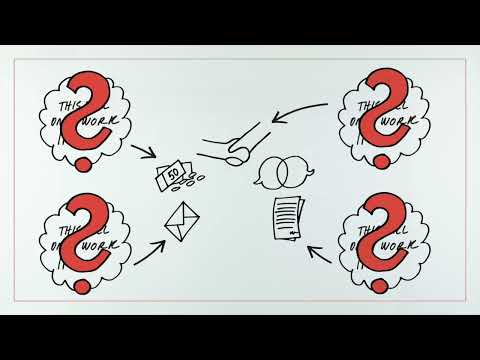FILL OUT THE THEORY OF CHANGE TEMPLATE
Introduce the participants to the timeframe and the purpose of the exercise by going through the following:
- What are we going to do today?
- Why are they invited?
- What are their roles (if participants do not know each other well)?
- What is the timeframe?
Split the participants into two groups if needed.
As this is a mini theory of change, it should be a rapid exercise. However, when distributing time for the template items, ensure to have a good amount of time to discuss the assumptions item. Discussing which critical conditions that must be in place to ensure project success is important to disclose any misalignment among team members and to scrutinise presupposed assumptions as a team. Being diligent in defining assumptions is therefore important to align teams on key risks to the solution implementation that must be monitored to ensure achievement of desired outcomes.
Starting from the top left, work your way through the template items and note down your responses. Use your responses in each box to guide what you note down in the next one. Try to be as specific and action oriented as possible when noting the responses. This will help you come up with more effective actions.
- Problem statement: What is the main problem that you want to solve, and what is your long-term vision on the change you want to accomplish?
- Target group(s): Who are the people affected by the problem you have identified, and what are your entry points in reaching this/these group(s)?
- Resources: What will we need? Do you have the required expertise in-house? Do you need to create new partnerships?
- Organisational preconditions: What do we need to be in place internally for successful implementation and sustaining of solutions? (E.g., certain skills and capacities, financial resources, leadership commitment and active support, or adjust existing processes, etc.)
- Activities: What are the key high-level activities we must do for the solution to achieve the desired effects?
- Results: What are the direct outputs of your activities/implementing your solution?
- Effects: What are the short-term, medium-term, and long-term measurable effects of implementing your solution and achieving your goals?
- Assumptions: What are the key assumptions that must be validated for the short, medium, and long-term effects to happen? For example, in relation to stakeholder support, implementation context, end-user needs and capacities, implementer capacities etc. This step is critical to reflect on, as it helps you spot potential risks and highlight key points in your monitoring plan.
Allow 30–60 minutes for this step.
Facilitator tips
Some participants may have been part of developing previous theories of change. Therefore, it can be good to remind participants that this is a mini theory of change and that it is okay not to capture all the small details for this version.
Remind participants to assess the solution and project through a protection, gender, and inclusion lens as well as considering conflict-sensitivity issues.
Theories of change can be tricky – especially the assumption part. Share your theory with colleagues who have experience working with theories of change and ask them to play ‘the devil’s advocate’.

